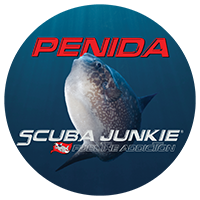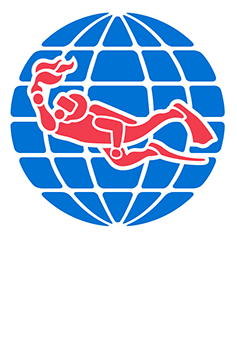
Nestled within the jagged coastline of Nusa Penida lies Crystal Bay, one of the island’s most popular dive sites. Renowned for its crystal-clear waters and vibrant, diverse marine life, diving Crystal Bay promises an exciting underwater adventure.
To ensure you’re fully prepared for this unforgettable dive site, we’ve compiled 7 essential insights about the location and topography of the dive site, the fascinating marine life you can encounter, diving conditions, environmental considerations, helpful tips, and the suitability for various courses.
Situated on the West coast of the island, the dive site is surrounded by breath-taking scenery covered in lush greenery, diving Crystal Bay is best done by boat takes around 10-15 minutes to get to from Scuba Junkie Penida on our custom built dive boats. The bay is on the edge of the channel facing neighbouring Nusa Ceningan.
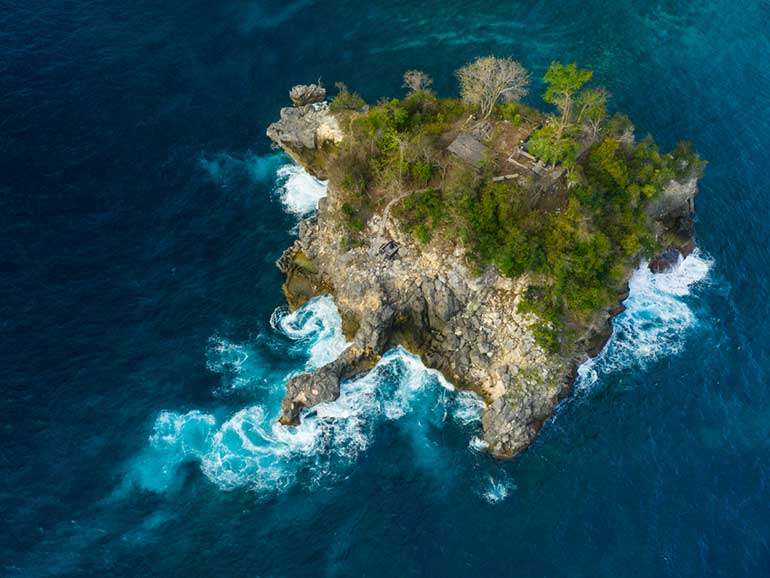
Diving Crystal Bay reveals a unique underwater landscape with two shallow reefs, starting at around 5-8 meters deep on either side of the bay. These reefs mirror each other, sloping down to meet a large sandy channel that extends into the deep blue.
Inside the bay is a large limestone island with funky rock formations. Under here lies what diving Crystal Bay is famed for - a steep sloping coral reef with mola cleaning stations!
As you face the beach, on the right side of the bay, you’ll encounter a wide bank of xenia soft coral and staghorn coral patches near the top and on the left side, diving Crystal Bay offers multiple coral bommies along the reef’s top, featuring a number of crevices and a few overhangs along the slope. This area provides a diverse and interesting environment for exploration.
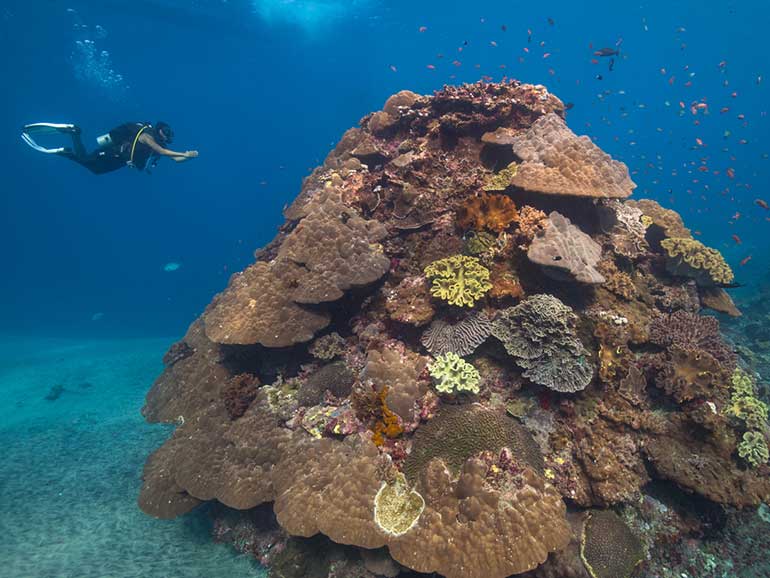
At the edge of the sandy channel, you'll find a distinctive mushroom-shaped coral bommie, starting at 9 meters deep and rising up to 2 meters beneath the surface. This spot is perfect for a safety stop, allowing divers to pass the time observing the vibrant marine life that surrounds it while concluding diving Crystal Bay.
The main attraction about diving Crystal Bay, is to encounter the famous Mola Alexandrini, also known as the sunfish or moonfish. These remarkable creatures prefer cold water and typically live at great depths, but when conditions are right, they venture up to shallower depths where recreational divers can encounter them cleaning. Mola sightings are especially abundant during the colder months (August to October) at Crystal Bay.
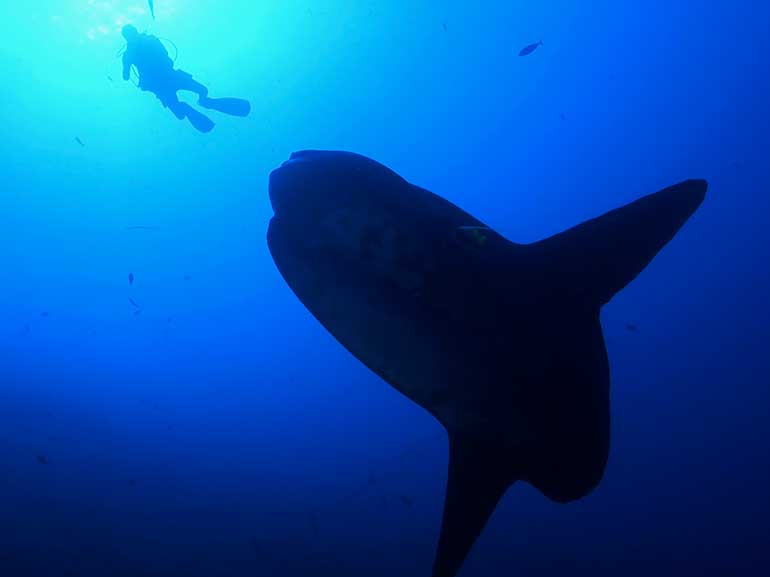
Beyond the mola, diving Crystal Bay offers a rich array of marine life to entice new and experienced divers alike.
In the sandy area of the bay, Crystal Bay hosts cuttlefish, garden eels and flounders hidden in the sand. Look for lionfish lurking in the shadows of the overhangs, octopuses and mantis shrimps hiding in the small cracks and crevices, scorpion fish and stonefish are often camouflaged among the coral and rocks and for those macro lovers, the soft coral is a blanket to an abundance of nudibranchs and other fascinating macro life. Keep an eye out for schools of big-eye barracuda hanging in the blue just off the reef, and you might even spot a marble ray gliding through the depths below.
Reef fish such as snapper, trevally, moray eels, unicornfish and of course clownfish and turtles are almost always spotted at the site.
Diving Crystal Bay can be challenging at times due to it's location and topography within the channel but if planned correctly to dive during specific tidal conditions, you can enjoy a pleasant experience avoiding the strong currents that can occur due to the underwater landscape.
At Scuba Junkie Penida, we take great care in planning every dive to ensure an enjoyable experience. While Crystal Bay is generally divable most of the time, there can be currents, thermoclines, surge or swell, and conditions can occasionally change quickly and unpredictably. However, there's no need to worry—our experienced guides are well-versed in reading the currents and navigating the reef, so you're in capable hands even if the conditions shift whilst diving Crystal Bay.
The water temperature you can expect when diving Crystal Bay varies depending on the time of year.
- During the warm season, December - May, it averages out at 28°C.
- During the transitional months, May - July & Nov, it’s between 22°C - 26°C, but can have cold thermoclines down to 19°C!
- During the cold season, August - October, it averages out at 21°C, with thermoclines as low as 16°C!
As the name "Crystal Bay" suggests, the visibility is an incredible crystal-clear 30m+ when you're in the sites notorious thermoclines, however occasionally the visibility vary from 10-20m.
If you’re lucky enough to encounter a mola during your dive at Crystal Bay, it’s an exciting experience, but it’s important to follow the Coral Triangle Center’s code of conduct for mola interactions (linked with Green Fins). This includes approaching these skittish creatures slowly, staying at least 3 meters away and avoiding sudden movements, noises, or camera flashes. Such actions can disturb their cleaning behaviour and cause them to swim away or dive back down to the depths.
While diving Crystal Bay, be mindful of your no-decompression limit (NDL) time, especially if you’re approaching the mola at greater depths. Ensure you follow your guide if the mola swims off into the blue, as there could be strong currents that you may not be aware of.
Additionally, Crystal Bay is home to scorpion fish, stonefish and lionfish, all of which are highly venomous. It’s crucial to maintain spatial awareness and avoid grabbing the reef, as these fish can be well-camouflaged. By being cautious and respecting these guidelines, you’ll help protect both the marine life and yourself during your dive.
When diving Crystal Bay, it’s especially important to stay close behind your dive guide. The currents here can change quickly and unexpectedly, so our guides will be constantly monitoring these shifts. They will direct you to safer parts of the reef if necessary so pay close attention to their instructions to ensure a safe and enjoyable dive.
At Crystal Bay, we occasionally have to swim against the current if it starts pulling out of the bay. It's simply unsafe to just drift with it. In these situations, using a strong frog kick is most effective as this technique conserves your energy better than a flutter kick, making it easier to manage the current.
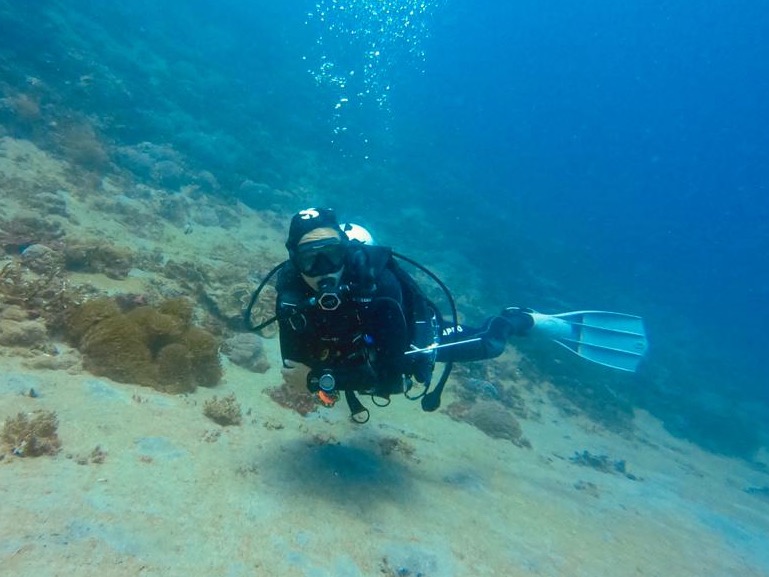
To further reduce the effort of swimming against the current, stay as close to the reef as comfortably possible without touching it. The reef will provide some shelter from the current and make it feel less intense.
If the current becomes too challenging, look for a coral bommie to take temporary shelter behind. This will block the current and give you a chance to catch your breath before continuing your dive.
Crystal Bay offers an ideal setting for a variety of course requirements due to the large, shallow sandy area within the bay and distinctive landmarks among the topography.
The large sandy area at the top of the bay, sitting at 6-7 meters deep, is a perfect area for first-time divers to complete the first few ocean skills of their Open Water course or for divers taking a refresher to re-learn and adjust their buoyancy without the risk of damaging the reef.
Diving Crystal Bay’s spacious environment is well-suited for Advanced Open Water Diver Course activities such as the navigation dive, optional search and recovery dive, or peak performance buoyancy dive. The Deep Adventure dive and Deep Specialty are both easily accomplished here on the reefs easy slopes. The bay also accommodates missing diver scenarios from the Rescue Diver Course, providing adequate space for various search patterns.
The unique topography and landmarks of Crystal Bay make it an excellent site for Divemaster mapping projects and guiding practice, as its distinctive features makes it easy to learn the dive site.
Is diving Crystal Bay on your bucket list? Get in touch today and our friendly team will help you plan your trip!
